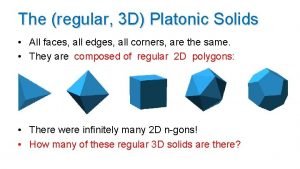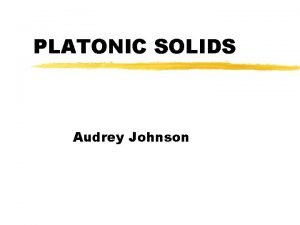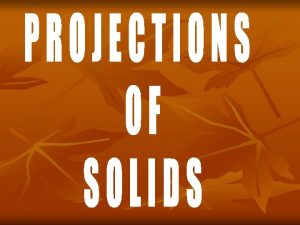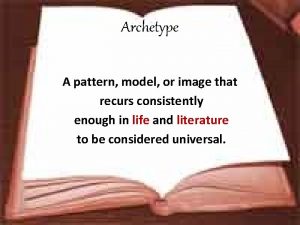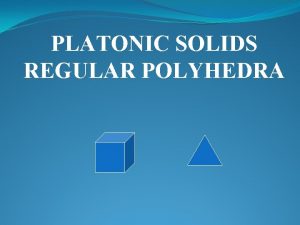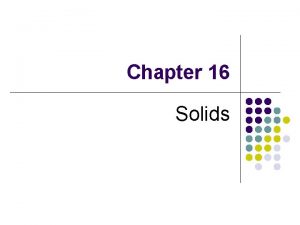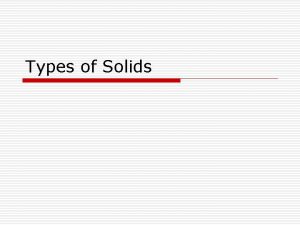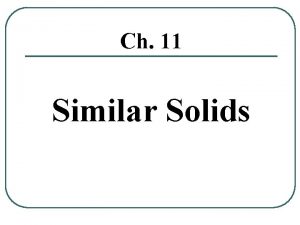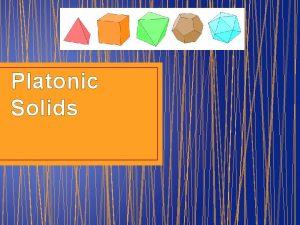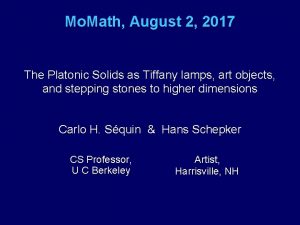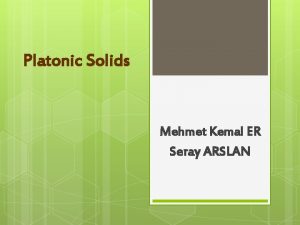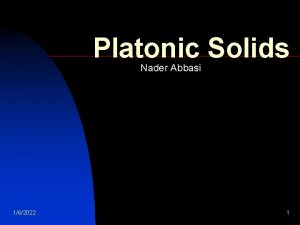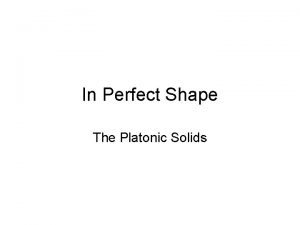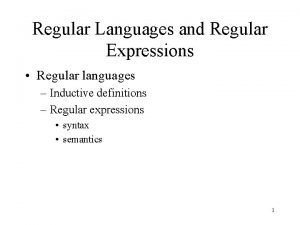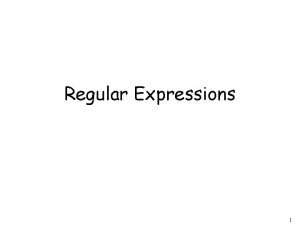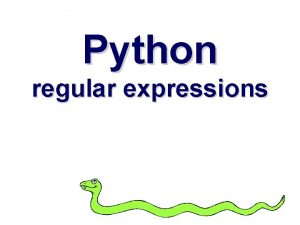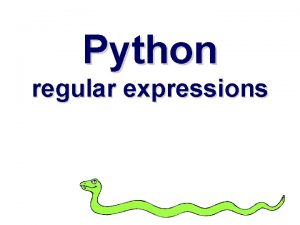The regular 3 D Platonic Solids All faces



































- Slides: 35

The (regular, 3 D) Platonic Solids • All faces, all edges, all corners, are the same. • They are composed of regular 2 D polygons: • There were infinitely many 2 D n-gons! • How many of these regular 3 D solids are there?

Making a Corner for a Platonic Solid Put at least 3 polygons around a shared vertex to form a real physical 3 D corner! • Putting 3 squares around a vertex leaves a large (90º) gap; • Forcefully closing this gap makes the structure pop out into 3 D space, forming the corner of a cube. • We can also do this with 3 pentagons: dodecahedron.

Why Only 5 Platonic Solids? Lets try to build all possible ones: • from triangles: 3, 4, or 5 around a corner: • from squares: only 3 around a corner: • from pentagons: only 3 around a corner: • from hexagons: “floor tiling”, does not bend! • higher n-gons: do not fit around a vertex without undulations (forming saddles); Now the edges are no longer all alike!

Utah Teapot The “Sixth Platonic Solid” -- if you belong to the Computer Graphics community.

Constructing a 4 D Corner: 2 D 3 D Forcing closure: 3 D creates a 3 D corner 4 D ? creates a 4 D corner

How Do We Find All 4 D Polytopes? • Reasoning by analogy helps a lot: -- How did we find all the Platonic solids? • Now: Use the Platonic solids as “tiles” and ask: – What can we build from tetrahedra? – or from cubes? – or from the other 3 Platonic solids? Need to look at dihedral angles: Tetrahedron: 70. 5°, Octahedron: 109. 5°, Cube: 90°, Dodecahedron: 116. 5°, Icosahedron: 138. 2°.

All Regular Polytopes in 4 D Using Tetrahedra (70. 5°): 3 around an edge (211. 5°) (5 cells) Simplex 4 around an edge (282. 0°) (16 cells) Cross-Polytope 5 around an edge (352. 5°) (600 cells) 600 -Cell Using Cubes (90°): 3 around an edge (270. 0°) (8 cells) Hypercube Using Octahedra (109. 5°): 3 around an edge (328. 5°) (24 cells) 24 -Cell Using Dodecahedra (116. 5°): 3 around an edge (349. 5°) (120 cells) 120 -Cell Using Icosahedra (138. 2°): None! : dihedral angle is too large ( 414. 6°).

Wire-Frame Projections • Project 4 D polytope from 4 D space to 3 D space: • Shadow of a solid object is mostly a “blob”. • Better to use wire frame, so we can also see what is going on at the back side.

Oblique or Perspective Projections 3 D Cube 2 D 4 D Cube 3 D ( 2 D ) We may use color to give “depth” information.

Constructing 4 D Regular Polytopes • Let's construct all 4 D regular polytopes -- or rather, “good” projections of them. • What is a “good” projection ? – Maintain as much of the symmetry as possible; – Get a good feel for the structure of the polytope. • What are our options ? A parade of various projections

5 -Cell or “ 4 D Simplex” • 5 cells (tetrahedra), • 10 faces (triangles), • 10 edges, • 5 vertices. (Perspective projection)

16 -Cell or “ 4 D-Cross Polytope” • 16 cells (tetrahedra), • 32 faces, • 24 edges, • 8 vertices.

4 D-Hypercube or “Tessaract” • 8 cells (cubes), • 24 faces (squares), • 32 edges, • 16 vertices.

24 -Cell • 24 cells (octahedra), • 96 faces, • 96 edges, • 24 vertices. 1152 symmetries!

24 -Cell Showing four congruent Hamiltonian cycles (in red, green, yellow, blue), each visiting every vertex exactly once.

120 -Cell • 120 cells (dodecahedra), • 720 faces (pentagons), • 1200 edges, • 600 vertices.

600 -Cell • 600 cells (tetrahedra), • 1200 faces, • 720 edges, • 120 vertices.

Polytopes in Higher Dimensions • Use 4 D tiles, look at “dihedral” angles between cells: 5 -Cell: 75. 5°, Tessaract: 90°, 16 -Cell: 120°, 24 -Cell: 120°, 120 -Cell: 144°, 600 -Cell: 164. 5°. • Most 4 D polytopes are too round … But we can use 3 or 4 5 -Cells, and 3 Tessaracts. • There are three methods by which we can generate regular polytopes for 5 D and for all higher dimensions.

“Dihedral Angles in Higher Dim. ” Consider the angle through which one cell has to be rotated to be brought in coincidence with an adjoining neighbor cell. Space 2 D Simplex Series 60° 3 D 70. 5° 4 D 75. 5° Cross 90° 109. 5° 120° Polytopes Measure 90° Polytopes 90° 5 D 78. 5° 6 D 80. 4° 90° 126. 9° 131. 8° 180° 90° 90°

Beyond 4 Dimensions … • What happens in higher dimensions ? • How many regular polytopes are there in 5, 6, 7, … dimensions ? Only THREE for each dimension! • Pictures for 6 D space: • Simplex with D+1 vertices, • Hypercube with 2 D vertices, • Cross-Polytope with 2 D vertices.

Hypercube Series • “Measure Polytope” Series • Consecutive perpendicular sweeps: 1 D 2 D 3 D 4 D This series extends to arbitrary dimensions!

4 D Hypercube Vertex-first Projection

Preferred Hypercube Projections • Use Cavalier Projections to maintain sense of parallel sweeps:

6 D Hypercube • Oblique Projection

6 D Zonohedron • Sweep symmetrically in 6 directions (in 3 D)

Simplex Series • Connect all the dots among n+1 equally spaced vertices: (Find next one above COG). 1 D 2 D 3 D This series also goes on indefinitely! The issue is how to make “nice” projections.

5 D Simplex: 6 Vertices • Two methods: Based on Octahedron Avoid central intersection: Offset edges from middle. Based on Tetrahedron (plus 2 vertices inside).

6 D Simplex: 7 Vertices Start from 5 D arrangement that avoids central edge intersection. Then add point in center: = skewed octahedron with center vertex

7 D and 8 D Simplices Use a warped cube to avoid intersecting diagonals

Cross Polytope Series (=Duals of Measure Polytopes) • Place vertices on all coordinate half-axes, a unit-distance away from origin. • Connect all vertex pairs that lie on different axes. 1 D 2 D A square frame for every pair of axes 3 D 4 D 6 square frames = 24 edges

4 D Cross Polytope … another model with three interwoven Hamiltonian cycles.

5 D Cross Polytope (10 vertices) Warped cube + 2 vertices

6 D Cross Polytope 12 vertices icosahedral symmetry (but edge-intersections)

7 D Cross Polytope 14 vertices cube + octahedron

5 D and Beyond The three polytopes that result from the – Simplex series, – Cross polytope series, – Measure polytope series, Duals ! . . . is all there is in 5 D and beyond! Dim. # 2 D 3 D 4 D 5 D 6 D 7 D 8 D 9 D … 5 6 3 3 3 Luckily, we live in one of the interesting dimensions!
 Platonic cells
Platonic cells Platonic solids
Platonic solids Regular solid definition
Regular solid definition Regular and irregular solids
Regular and irregular solids Five regular solids
Five regular solids A cube has 6 faces 8 vertices and 12 edges
A cube has 6 faces 8 vertices and 12 edges Which grammar generates regular language?
Which grammar generates regular language? Young person from the provinces archetype
Young person from the provinces archetype The task archetype definition
The task archetype definition Platonic ideal archetype
Platonic ideal archetype The spunky kid in harry potter
The spunky kid in harry potter Platonic relationship adalah
Platonic relationship adalah Altruistic love
Altruistic love Nn love
Nn love Metaphysical poetry
Metaphysical poetry Name
Name Tỉ lệ cơ thể trẻ em
Tỉ lệ cơ thể trẻ em Thế nào là mạng điện lắp đặt kiểu nổi
Thế nào là mạng điện lắp đặt kiểu nổi Lời thề hippocrates
Lời thề hippocrates Vẽ hình chiếu đứng bằng cạnh của vật thể
Vẽ hình chiếu đứng bằng cạnh của vật thể Quá trình desamine hóa có thể tạo ra
Quá trình desamine hóa có thể tạo ra Các môn thể thao bắt đầu bằng tiếng bóng
Các môn thể thao bắt đầu bằng tiếng bóng Hát kết hợp bộ gõ cơ thể
Hát kết hợp bộ gõ cơ thể Khi nào hổ con có thể sống độc lập
Khi nào hổ con có thể sống độc lập điện thế nghỉ
điện thế nghỉ Các loại đột biến cấu trúc nhiễm sắc thể
Các loại đột biến cấu trúc nhiễm sắc thể Biện pháp chống mỏi cơ
Biện pháp chống mỏi cơ Phản ứng thế ankan
Phản ứng thế ankan Trời xanh đây là của chúng ta thể thơ
Trời xanh đây là của chúng ta thể thơ Gấu đi như thế nào
Gấu đi như thế nào Thiếu nhi thế giới liên hoan
Thiếu nhi thế giới liên hoan Fecboak
Fecboak Một số thể thơ truyền thống
Một số thể thơ truyền thống Thế nào là hệ số cao nhất
Thế nào là hệ số cao nhất Lp html
Lp html Sơ đồ cơ thể người
Sơ đồ cơ thể người
